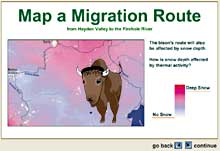
|
Lobby > Exhibits > Hot Spring Ecology > Wildlife > Hydrothermal Hopscotch WildlifeHYDROTHERMAL HOPSCOTCH Winter in Yellowstone is marked by cold temperatures and deep snowfalls. Snow depth influences how much forage is available, as well as how much energy a bison must use in order to survive. Snow depth also influences an animal's health, how well it can move, and how well it can avoid predators. During the winter, when it is necessary to conserve as much energy as possible, many of the bison in the central part of the park migrate from Hayden Valley to the Firehole River in search of better winter forage.  Many scientists think that bison don't depend on groomed roads to migrate. Instead they "hopscotch" between areas influenced by thermal activity.
Although capable of navigating through deep snow, such sites are refuges of warmth and plentiful forage, and allow the animals to recoup before tackling the next stage of the trek. Once ungulates are familiar with such areas, the same route is used for subsequent journeys. Next | 1 > 2 > 3 > 4 > 5 | Next Section: Plants |
|
||||||||||||||||||||||||||||||||


